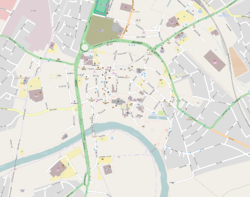| St Francis Xavier Church | |
|---|---|
 Front entrance | |
| 52°03′18″N2°43′01″W / 52.0551°N 2.7169°W | |
| OS grid reference | SO5093939880 |
| Location | Hereford |
| Country | England |
| Denomination | Roman Catholic |
| Website | SFXHereford.org.uk |
| History | |
| Status | Parish church |
| Founder(s) | Society of Jesus |
| Dedication | St Francis Xavier |
| Relics held | St John Kemble |
| Architecture | |
| Functional status | Active |
| Heritage designation | Grade II* listed [1] |
| Architect(s) | Charles Day |
| Style | Neoclassical |
| Groundbreaking | 19 September 1837 |
| Completed | 7 August 1839 |
| Construction cost | £16,000 |
| Administration | |
| Province | Cardiff-Menevia |
| Archdiocese | Cardiff-Menevia |
| Deanery | Hereford |
St Francis Xavier Church is a Roman Catholic Parish church in the city centre of Hereford, Herefordshire. The neoclassical-style church was built in 1839 and was designated a Grade II* listed building on 10 June 1952. [1] It is in the Hereford Deanery of the Archdiocese of Cardiff-Menevia.



